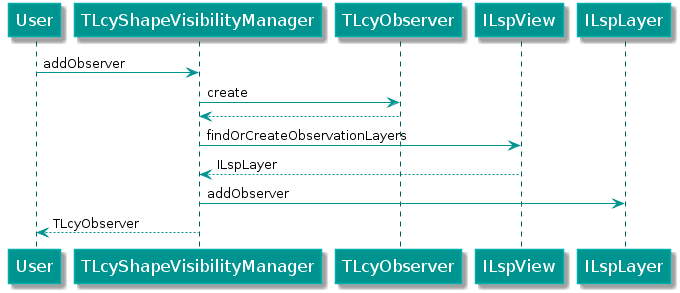High-level overview
The TLcyShapeVisibilityAddOn and TLcyLspShapeVisibilityFormatAddOn are designed to:
-
Mark existing objects on a map as observers
-
Mark other objects on the map as being under observation by one or more observers
-
Visualize the results of the visibility calculations on the map
To learn more about visibility calculations in LuciadLightspeed, see About shape visibility.
The most important classes are:
-
TLcyShapeVisibilityManager: a manager that allows you to create observer object (TLcyShapeObserver) instances for an existing object on the map. -
TLcyShapeObserver: the observer domain object. It has methods to:-
Start observing another object
-
Stop observing another object
-
Obtain a reference to the objects that are being observed
-
Obtain a reference to the object for which the observer was created
-
-
TLcyShapeObservationResult: the domain object representing the result of the visibility calculation. The result has methods to:-
Obtain a reference to the observers
-
Obtain a reference to the object that is being observed
-
Obtain the
ILcdReferencedMatrixView, which is the result of the visibility calculation
-
Creating an observer
You create an observer through the TLcyShapeVisibilityManager:
//Retrieve the manager from the services
TLcyShapeVisibilityManager manager = aLucyEnv.getService(TLcyShapeVisibilityManager.class);
//Ask the manager to create an observer for the specified domain object
//Interacting with the manager must happen on the AWT thread (Event Dispatch Thread)
if (manager.canAddObserver(aDomainObjectContext)) {
TLcyShapeObserver pointObserver = manager.addObserver(aDomainObjectContext);
}The addObserver method:
-
Creates the observer.
-
Adds it to the map. If it is the first observer, the necessary layers are added to the map.
-
Returns the created observer.

The created observer is automatically kept in-sync with the object for which it was created:
-
If the object moves, the observer is moved as well. New visibility calculations are automatically triggered.
-
If the object is removed, the observer will be removed as well. If the observer is removed:
-
All calculation results with that observer as the single observer are removed as well.
-
All results with multiple observers including the removed observer, are re-calculated.
-
Start observing an object
The TLcyShapeObserver class has methods to start and stop observing an object:
//Find the observer model in the view
ILcdModel pointObserverModel = view.getLayers()
.stream()
.map(ILcdLayer::getModel)
.filter(model -> Objects.equals(TLcyShapeVisibilityAddOn.OBSERVER_MODEL_TYPE_NAME, model.getModelDescriptor().getTypeName()))
.findFirst()
.orElseThrow(() -> new RuntimeException("Cannot find the model containing the observers"));
//Let the observer observe another shape
//As this modifies the point observer, it requires a lock on the point observer model
try (TLcdLockUtil.Lock autoUnlock = TLcdLockUtil.writeLock(pointObserverModel)) {
if (pointObserver.canObserve(aDomainObjectContextToObserve)) {
//Tell the observer to start observing another object
pointObserver.startObserving(aDomainObjectContextToObserve);
//Indicate to the model that the observer has been changed
pointObserverModel.elementChanged(pointObserver, ILcdModel.FIRE_LATER);
}
} finally {
pointObserverModel.fireCollectedModelChanges();
}Calling the startObserving method:
-
Creates a
TLcyShapeObservationResultif necessary. If the object is already under observation by another observer, the existing result will be re-used and updated. If it is not, a new result instance is created. -
Adds the calculation result to the map. If necessary, a layer for the results is added to the map
-
Returns the result. At this point, the visibility calculation in the result hasn’t been updated yet for the new observer.
-
A new calculation is scheduled on a background thread. When that thread completes the calculation, it will update the result.
